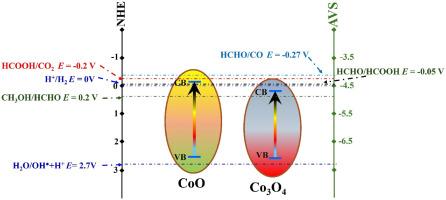Visible-light-driven methanol photo-reforming over cobalt oxides nanofibers: Insights into synthesis, bandgap engineering, and catalytic efficiency
Q3 Materials Science
引用次数: 0
Abstract
Photocatalytic methanol photo-reforming stands as a promising avenue for sustainable hydrogen production, with potential applications in clean energy generation. In this study, we investigate the utilization of CoO/Co3O4 nanofibers as a photocatalyst for methanol photo-reforming, evaluating its performance under different reaction conditions. The synthesized nanofibers are employed with both pure methanol and methanol/water mixtures and compared against TiO2 nanoparticles for reference. Gas evolution rates and composition are analyzed to elucidate the catalytic behavior of the nanofibers. Results reveal that the CoO/Co3O4 nanofibers exhibit superior catalytic activity, yielding high gas evolution rates with pure methanol; 600 mmol/gcat·s. However, the addition of water leads to a sharp decrease in gas production rate (66.9 mmol/gcat.s), attributed to competitive water adsorption on the catalyst surface and drastic change in the reaction kinetics. Gas analysis demonstrates the predominant production of carbon monoxide and hydrogen with pure methanol, while carbon dioxide is detected in the presence of water. In contrast, TiO2 nanoparticles primarily yield carbon dioxide and hydrogen, with no carbon monoxide detected. These findings provide valuable insights into the catalytic mechanisms and selectivity of nanofiber-based catalysts for methanol photo-reforming, paving the way for the development of efficient and selective photocatalytic systems for sustainable energy production.

钴氧化物纳米纤维上的可见光驱动甲醇光重整:对合成、带隙工程和催化效率的见解
光催化甲醇光重整是一种很有前途的可持续制氢途径,在清洁能源生产中具有潜在的应用前景。在本研究中,我们研究了CoO/Co3O4纳米纤维作为甲醇光重整的光催化剂,并对其在不同反应条件下的性能进行了评价。将合成的纳米纤维与纯甲醇和甲醇/水混合物一起使用,并与TiO2纳米颗粒进行比较作为参考。分析了气体的释放速率和组成,阐明了纳米纤维的催化行为。结果表明,CoO/Co3O4纳米纤维具有优异的催化活性,在纯甲醇中产生较高的析气速率;600年更易gcat·s。然而,水的加入导致产气速率急剧下降(66.9 mmol/gcat)。S),归因于水在催化剂表面的竞争性吸附和反应动力学的剧烈变化。气体分析表明,一氧化碳和氢的主要生产与纯甲醇,而二氧化碳是在存在的水检测。相比之下,二氧化钛纳米颗粒主要产生二氧化碳和氢气,没有检测到一氧化碳。这些发现为甲醇光重整纳米纤维催化剂的催化机制和选择性提供了有价值的见解,为开发可持续能源生产的高效和选择性光催化系统铺平了道路。
本文章由计算机程序翻译,如有差异,请以英文原文为准。
求助全文
约1分钟内获得全文
求助全文
来源期刊

JCIS open
Physical and Theoretical Chemistry, Colloid and Surface Chemistry, Surfaces, Coatings and Films
CiteScore
4.10
自引率
0.00%
发文量
0
审稿时长
36 days
 求助内容:
求助内容: 应助结果提醒方式:
应助结果提醒方式:


